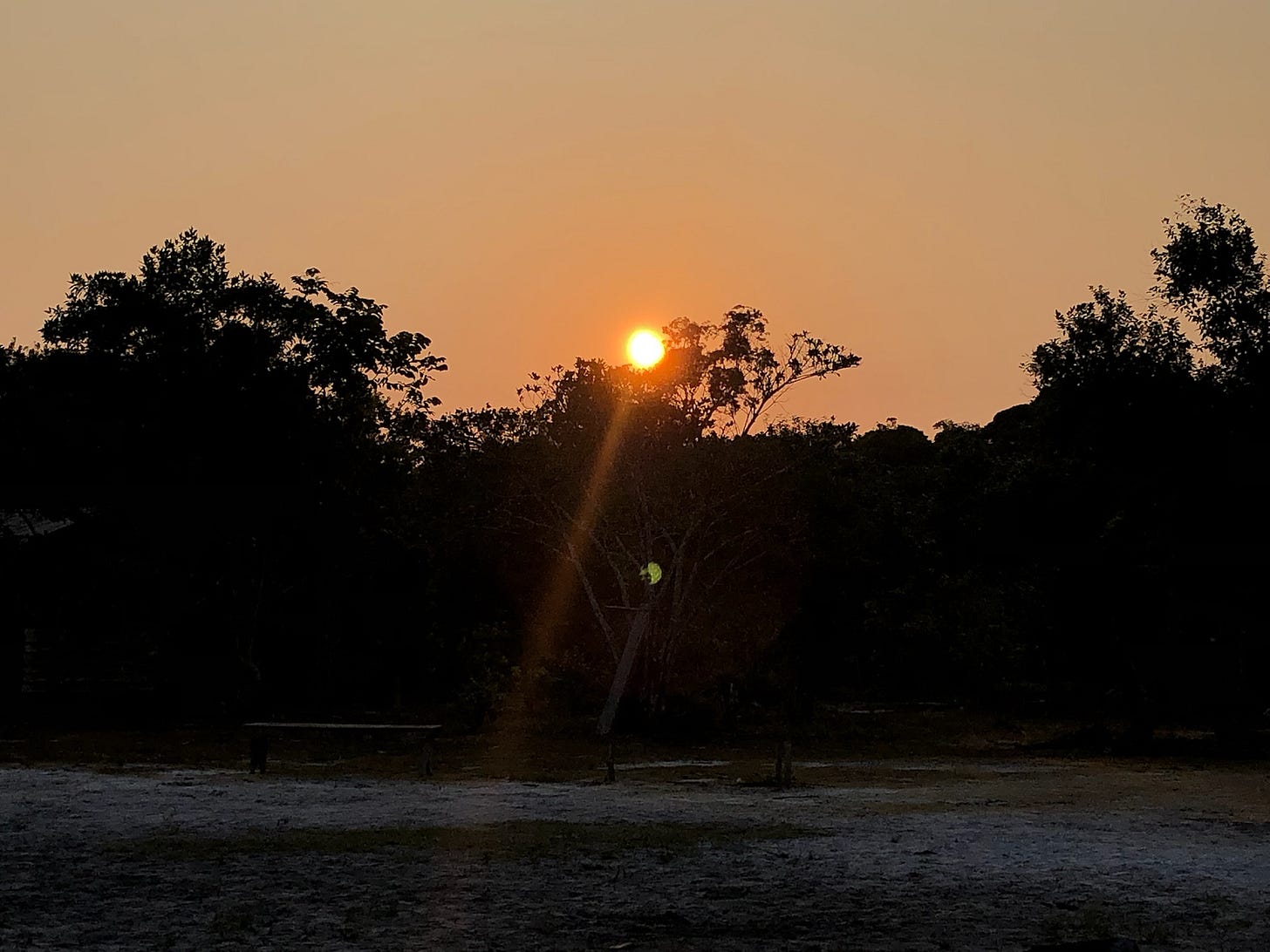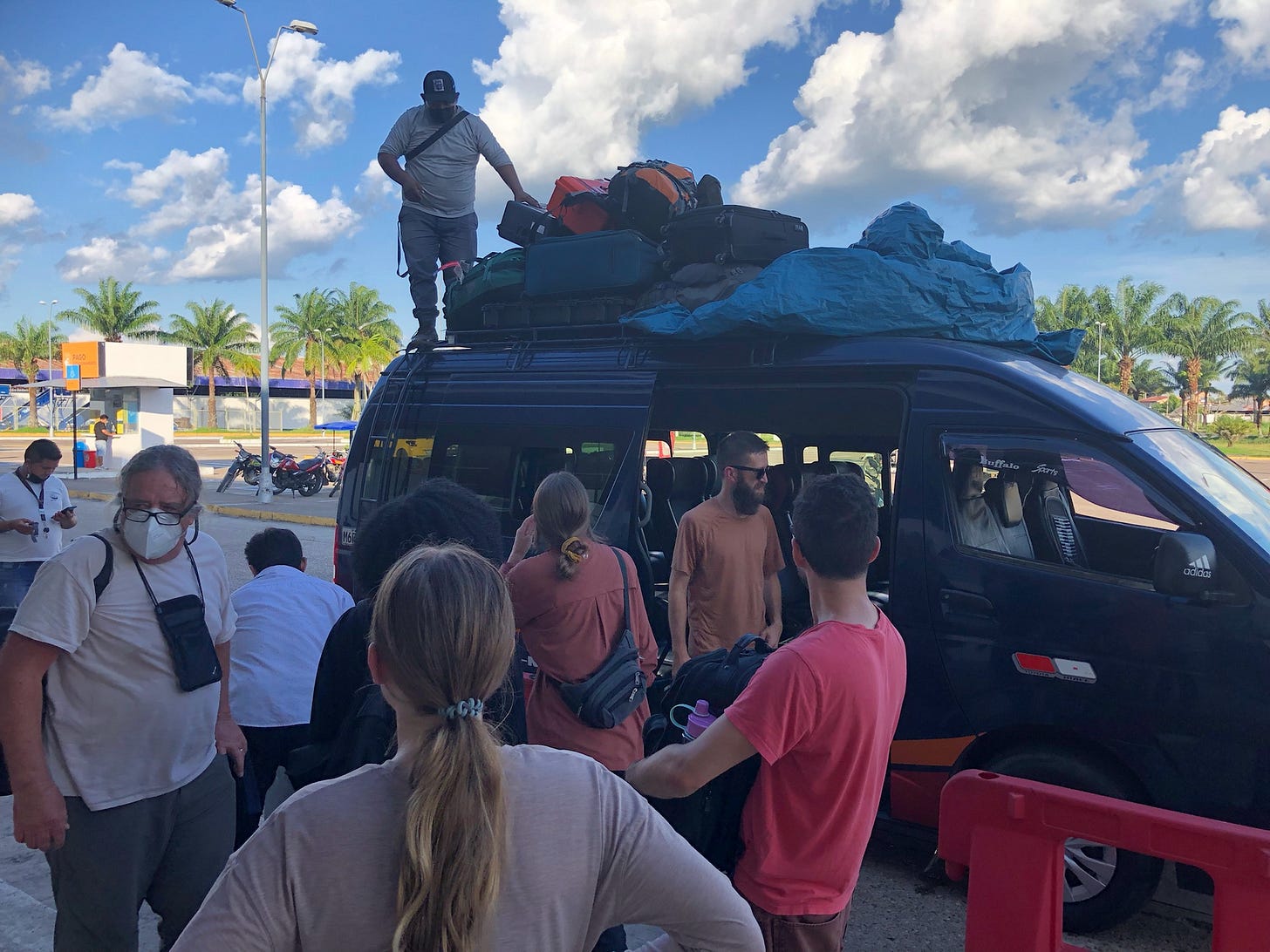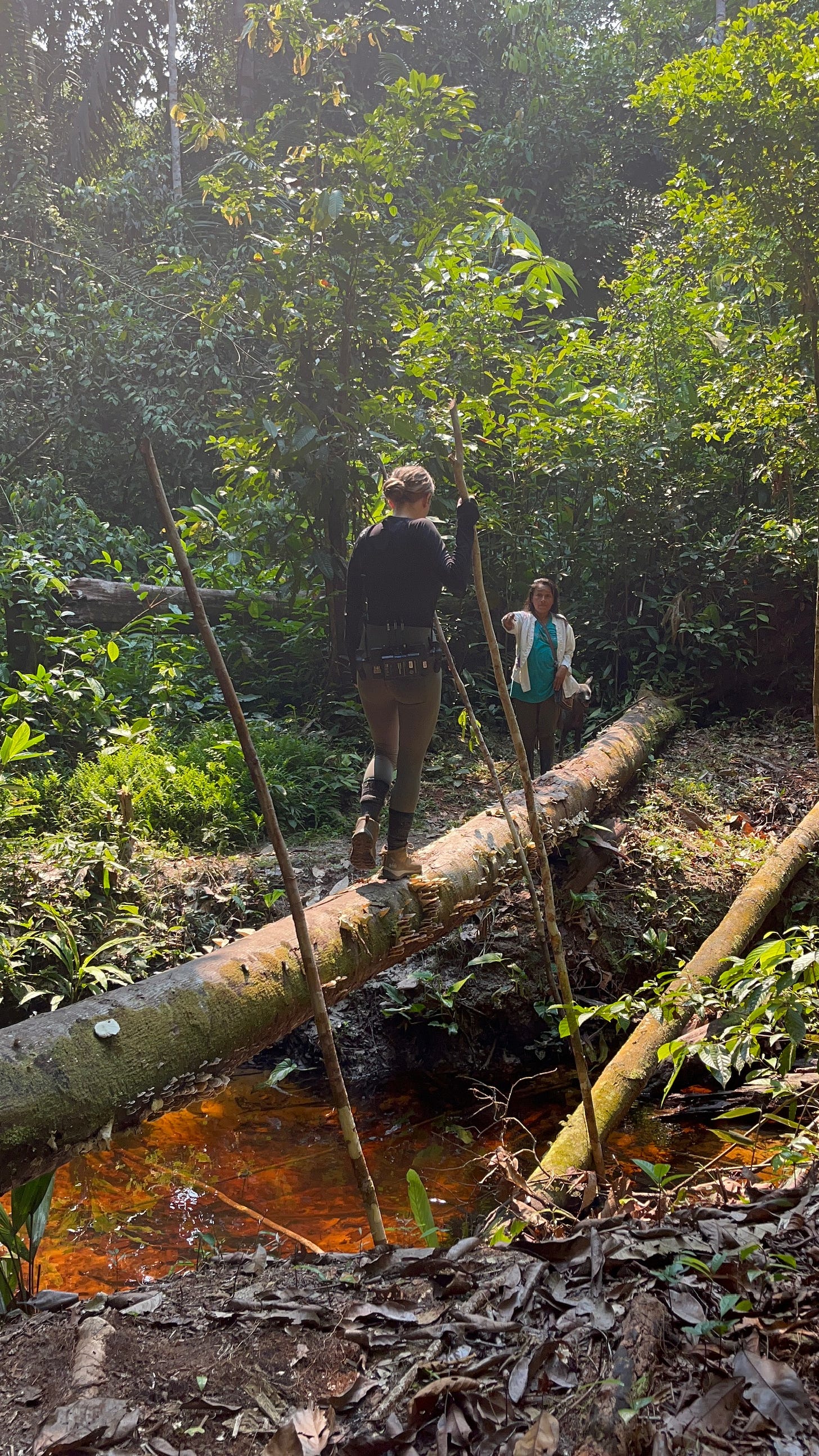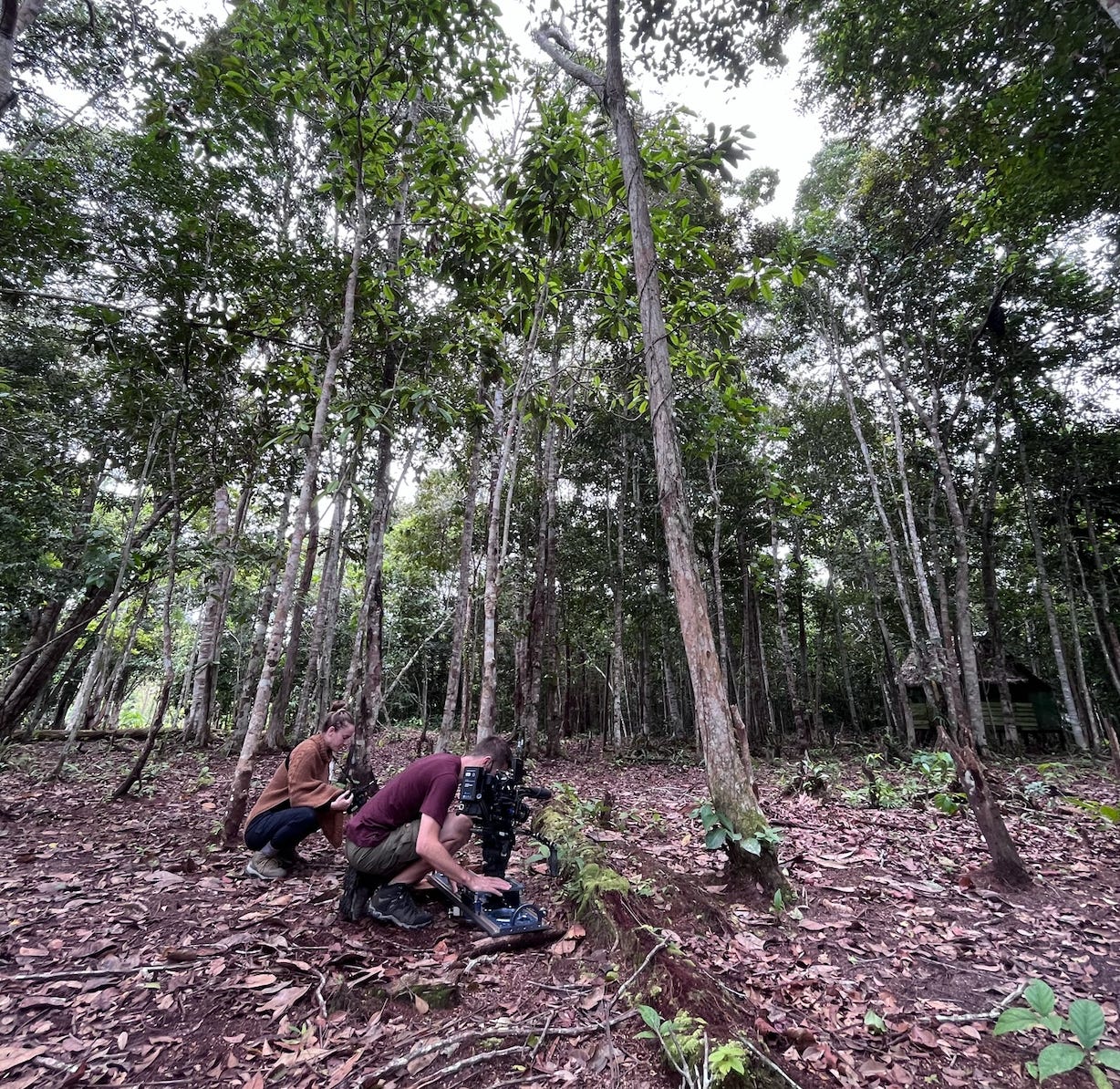Things I Learned About Filming Shamans While My Marriage Ended
(A repost from my Filmmaker Magazine article)
This article was just published in Filmmaker Magazine. Feel free to read it there if you’re feeling fancy.
In 2021, I was sitting in a dark room in the depths of the Andes, listening to the steady chanting of a Peruvian Shipibo shaman guiding me through a wildly personal and intense ayahuasca ceremony. I was bawling my eyes out, purging what felt like an entire lifetime of pain through my tears, the tribally-robed medicine man before me some kind of God pulling the abuses of my past up and out of my body with his song.
The next day, I saw this same man eating oatmeal in Nike sweatpants and jovially WhatsApping his wife. I was disoriented: I could not draw a coherent line between the transcendence of my experience and the utter banality of the morning after. This collision between the mystical and mundane would haunt me for months, eventually driving me to make my first documentary—though I didn’t yet understand how my own attempts to capture this dichotomy would mirror the very contradictions I sought to explore.
She is a Shaman was ambitious in a way that only a first film can be. The project’s very existence depended on my naïveté—the inability to grasp the unimaginable complexity of capturing an atemporal medicine woman’s life in a environment where every piece of equipment was a potential casualty to humidity, heat or the jungle’s endless appetite for anything electronic.
I imagined my first documentary, given the subject matter, would begin with some profound moment of artistic inspiration. Instead, it began with dozens of emails to ayahuasca centers with functioning Wi-Fi, hoping to reach mystics through younger, tech-savvy relatives. In the end, I narrowed that list down to five, but most heavily pursued a woman named Estela Pangoza—at the time, the first and only woman to operate her own ayahuasca center in Peru.
My marriage was unraveling in parallel with pre-production. I spent days alternating between marathon, marriage-ending conversations half-sparked by my initial experience with ayahuasca in 2021, and solo pre-production planning: researching visas, contacting potential crew, Zooms with healers of various pedigrees over choppy connections. I had set aside a chunk of my own savings for filming. When I had taken ayahuasca in 2021, I was saving up to buy a home in Los Angeles. In a tale as old as ayahuasca-retreat-returnee-time, I had decided instead to use a portion of my savings for art. I’ve been called reckless, but even today, I don’t regret it.
Throughout my search for the filming subject and location, I held out hope for Estela, who was slow to respond to my emails, and upfront about her desire to both meditate on the decision to have her life filmed in such an intimate way and seek council from the ayahuasca itself. In the end, four of the five shamans I spoke to agreed, but I was in a state of limbo for some months as I awaited Estela’s decision. In March of 2022, after a short trial separation with my husband, I received a call from him in which we agreed that divorce was inevitable. I awoke the next morning to an email from Estela: she had been visited by an “energy” that night that had told her now was the time to agree to the project. I was ready, and so was she.
Within the month, I had successfully assembled a five-person crew, mainly consisting of talented professionals willing to take a chance despite my inexperience. This included my cinematographer and AD, who were old friends, and my stepdad, who had prior experience on film sets and was more or less paternally obligated to believe in me. Six of my close friends volunteered to have their ceremonies captured on film, and were absolutely fearless in the face of my assurances that a large, Sony FX9 might be inches from their faces during what was likely to be some of the most transformative moments of their lives. By August of that year, we were all en route to the Amazon basin.
I arrived in Peru armed with 15 cases of high-end equipment, ready to capture the ancient wisdom of the jungle in 4K. As one might imagine, the Peruvian government was alarmed by the volume of luggage despite the legal permits I had prearranged, and upon our arrival at customs, we had to beg, borrow and ultimately bribe our cases through the border. These cases were then, to my horror, haphazardly tied to the roof of a small van that carried my crew to the edge of the jungle, where we were introduced to a different shaman who had electricity in his home. We left the bulk of our equipment here, knowing that the small generator at the ayahuasca retreat was only powerful enough to run a few lightbulbs. Within days, it became clear that the Amazon had its own ideas about production value. Our carefully planned equipment setup— filters, the oversized slider, the odds and ends of modern filmmaking—sat largely untouched, an early sign that the jungle would strip away my preconceptions one by one.
Estela’s center was a few miles deep into the rainforest, a roughly 30-45 minute journey through a winding, monkey-filled narrow road of sand. Several tuk-tuks were waiting for us at this shaman’s house. As we bounced through the winding jungle path to the retreat center, we clung to the most valuable cases (like the camera and batteries) for dear life, praying we’d avoid shocks to the equipment.
Our plan, which we successfully executed throughout the shoot, was to create a rotation of batteries each morning. My stepdad become our runner, riding a pre-arranged tuk-tuk to the roadside shaman’s home and swapping out batteries in a well-coordinated charging cycle. Working without electricity became habit, and aside from a few scares over whether or not sand had impacted the camera lens, everything remained functional and operable.
As a first-time director, I was able to rely on my more experienced crew for the technical side of the shoot—and for that I am grateful. When it came to navigating ethical dilemmas, however, I was entirely on my own. My staunch intention for the film was to avoid the entrapments of most ayahuasca films I had seen prior: psychedelic vacation-baiting, “these places are actually dangerous!” cliches. When I imagined the completed film, I pictured an idyllic slice-of-life portrait exploring the quaint realities of a remote healer’s life, something peaceful and meditative that exemplified the oddities of navigating the line between modernity and tradition.
When we arrived at Estela’s retreat, we were greeted by both her and the four shamans she employs, along with their entire families in traditional Shipibo garb, in a colorful display of singing, drumming and dancing. They had assumed we would be eager to film this, and we had been excitedly told by the tuk-tuk drivers to have our cameras ready. I was grateful for the intention of the greeting, but in some small way my heart sank when we arrived. I understood in that moment that perhaps Estela had misunderstood at least some of my goal—I was absolutely un-interested in traditional touristic displays. Still, I had pre-committed to a (in truth, inflexible) sense of integrity: I filmed what I was asked to film, avoided what I was asked to avoid and watched a mountain of potential footage slip away in the name of politeness.
Our first night there was filled with the sounds of a young woman’s moans and wails. We were told that she had been attacked by a swarm of bugs and that these bites had turned into gaping, golf-ball-sized wounds. When asked if medical care was necessary, we were assured that she was being tended to. A few Western visitors at the retreat were “legacy” guests there for some weeks or months, participating in long-form ayahuasca ceremonies on a weekly basis. They claimed that she was being “punished” by the ayahuasca for breaking some of the unspoken rules of the retreat.
This “broken rule” impacted our shoot in a fairly significant way. Apparently, she had fallen in love with one of the “legacy” guests, who had promised to be our on-set translator from Spanish to English. By morning, we received word that they had both run away—perhaps as a romantic gesture, perhaps to seek medical attention for her wound, or perhaps to avoid the (in my ultimate opinion) judgements from the other guests at the retreat.
We proceeded with the shoot despite the language barrier, and got occasional translational assistance from one of the “legacy” guests. In some ways, this informed the final narrative nature of the film. In-depth interviews with Estela were still conducted through me, and my questions were appropriately conveyed to her—but I didn’t know many of her answers until after the shoot was complete. The lack of explicit communication was disappointing, but without words, Estela and I developed a different language: subtle nods, careful glances, the weight of shared silence. We spent a great deal of time looking at each other, feeling out each other’s presence and, in the end, assimilating into a quiet form of understanding.
During the first days of filming, Estela took mysterious trips into town, outfitted with sparkly blue eyeshadow and dressed in nice jeans and blouses. She asked that we avoid joining her on these excursions, saying that having a camera in town would draw the attention of thieves and bad actors. We used these days to capture b-roll and footage of the other shamans at the center.
Each time I turned off the camera at Estela’s request, I wrestled with documentary ethics in real time. Was I protecting her privacy or sanitizing her reality? Still, I was able to capture at least some of the stranger elements of Estela’s life—for example, various moments with her 28-year-old boyfriend (Estela herself was 51 at the time), and brief shots of young men patrolling her retreat each night with rifles. (Their claim was that they were on the lookout for cougars, but our “legacy” insiders said it was to guard the perimeter from robbers interested in American suitcases.)
On one occasion, we were filming footage in the back portion of Estela’s home and heard an approaching English-speaking woman yelling for Estela. We hadn’t seen this woman before, and we were poised to capture the footage. Estela promptly pleaded with us to turn the cameras off. We did—the microphones, too. The English-speaking woman proceeded to accost Estela with an aggression that bordered on manic. Estela’s replies were imperceptibly quiet, but her tone conveyed sympathy and grace. The woman continued to yell: “I want water! I’m starving! You can’t do this to me!” Eventually, Estela began preparing a meal, and the woman left Estela’s home, rice and fish in hand.
Rumors spread through the retreat like a game of telephone: she was either a Canadian fugitive hiding from the law, or an initiate deep in the “madness phase” of a shamanic isolation ritual. I never learned the truth, and never filmed her.
Every time I turned off the camera for Estela, I thought about my own solitary leap—both of us women carving out space in environments that didn’t expect us to succeed. Perhaps I protected her story because I saw, in some small part, my own reflection in it. When I watch the film now, the footage I didn’t capture hovers somewhere just behind the final cut—darker, messier, perhaps more true, perhaps just more sensational.
Regardless of the reasoning, I didn’t quite understand throughout the shoot that it’s better to simply capture it all, politeness be damned, and make moral decisions about what to include later. If I were to bring a single lesson into my next film, it’d be this one—film it all—and more importantly, the classic piece of advice that I somehow managed to miss: release, with a viciously open mind, all preconceived narrative notions. The deeper I got into filming, the more I realized I was unconsciously sorting moments into two piles: the “real” story I wanted to tell, and the messy reality I was choosing to ignore. It was only later that I understood the irony—in my quest to unravel one dichotomy, I had created another. My polite refusal to film certain moments wasn’t just about protecting Estela; it was about protecting my own narrative, my own idea of what this film should be.
On the last day in the jungle, my crew and I packed up all the equipment and participated in our own ayahuasca ceremony together. The two-week shoot had been a maze of bug spray, sweat, vines, chanting and camera wires. In the ceremony, I felt the weight of both the shoot and my divorce lifting away. I thought of Estela’s courage and independence, and felt the freedom in my own aloneness. I gave myself a small moment of acknowledgement for undertaking such a wild endeavor. Estela told the crew that she was “blessing” the film and was thankful we had come.
I returned to my small hut, profoundly tired and still feeling the effects of the ayahuasca. Laying in bed, I played through the decision to make the film, the courage of Estela to undertake her own healing center, and all the ways in which I had already succeeded and failed at my first project. At some point, in my half-drug-half-fatigue stupor, I noticed a long, yellow cable hanging above my bed. “How’d that get here?” I mused. When the cable moved of its own accord, I noticed that it was, in fact, not a cable—but a 15-foot-long snake with two black eyes fixed upon me. I leapt from the bed and watched it for a moment before seeking out Estela for help.
She sent her boyfriend to my hut, who proceeded to chase the snake out through the roof and into the nearby grass. He then beat the snake to death with a large stick, and triumphantly held its carcass in the air as if it were a trophy. I felt conflicted about my feelings on the matter: grateful that the snake was gone, surprised that the violence was celebrated. Estela was unaffected by the snake’s demise. She nodded, her expression conveying something along the lines of “so it goes.” I thanked her boyfriend and returned to my hut.
Lying in bed that evening, I watched the shadows move across the ceiling where the snake had been. “I should have filmed that.” I thought, before drifting off to sleep. “I wonder if I should have filmed that.”
She is a Shaman is currently available for free on YouTube, you can watch it here.







